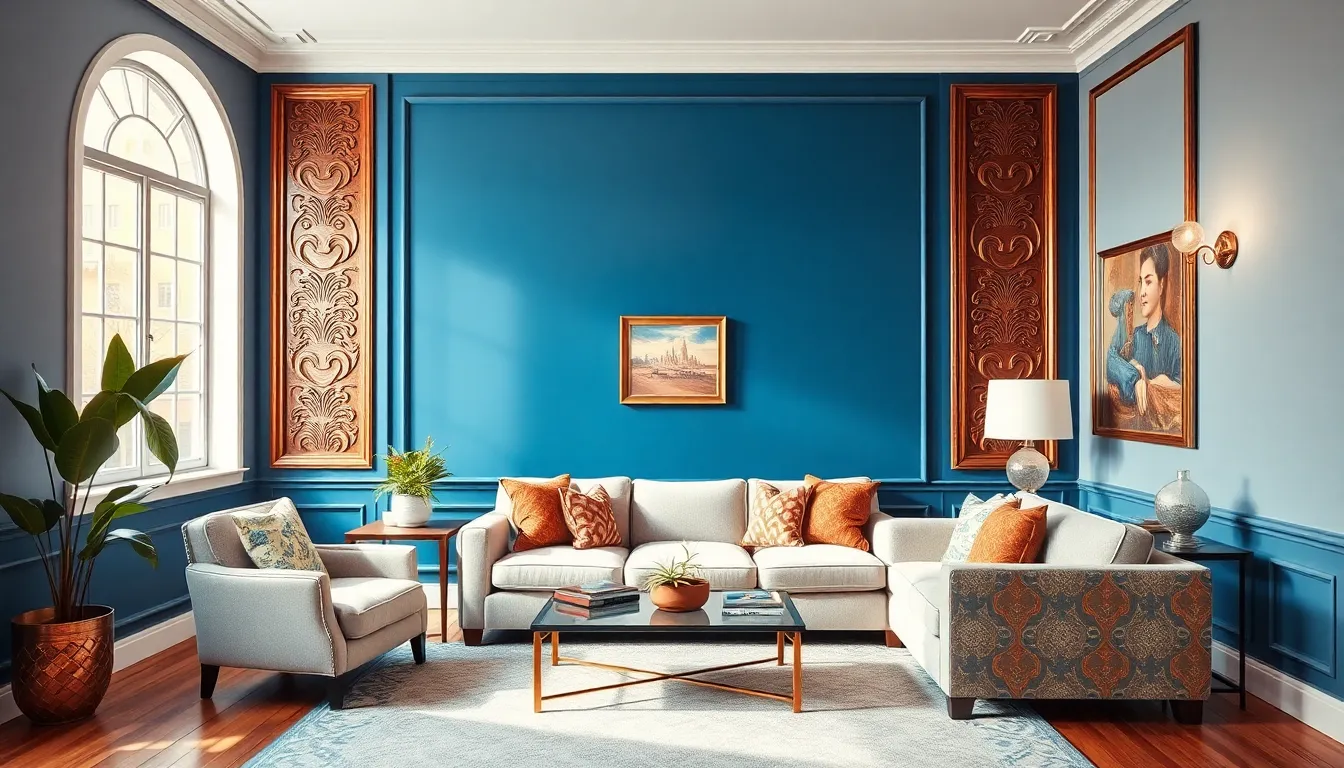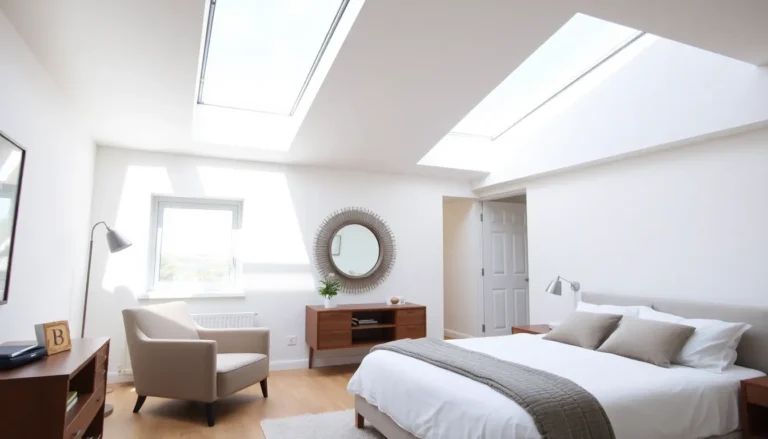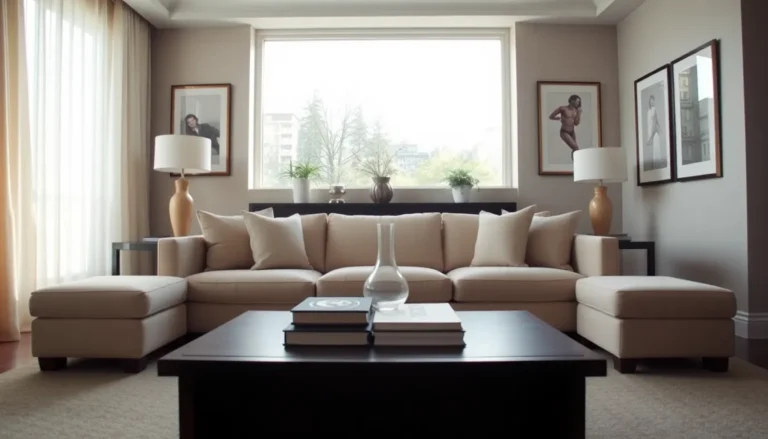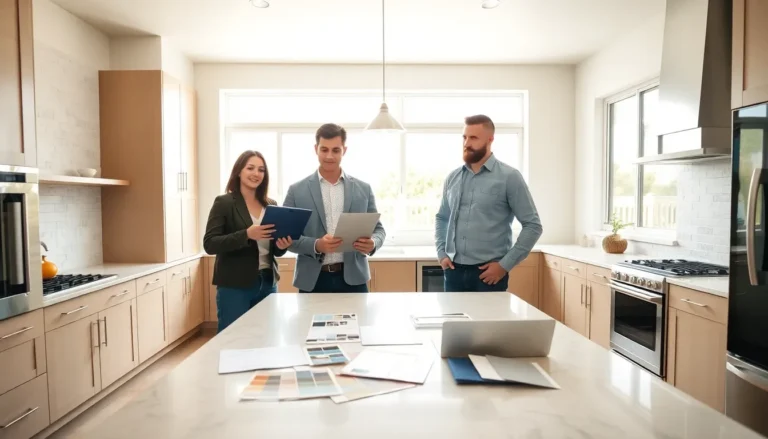Accent walls are like the bold friend who shows up to the party and instantly steals the spotlight. They add personality and flair to any room, transforming bland spaces into vibrant havens. Whether it’s a daring splash of color or a textured masterpiece, an accent wall can make a statement without saying a word.
Table of Contents
ToggleWhat Are Accent Walls?
Accent walls serve as focal points in a room, providing visual interest and depth. These walls typically feature a striking color, unique texture, or bold pattern that contrasts with other walls in the space. By integrating an accent wall, homeowners can transform ordinary environments into engaging displays of style.
Designers often choose a wall that draws attention, such as the one behind a bed or a sofa, to create a dramatic effect. Materials used for accent walls vary, including paint, wallpaper, wood panels, and stone. Each option contributes to the overall aesthetic, influencing the room’s ambiance.
In terms of color choice, vibrant shades like deep blue or rich emerald green can energize a space. Alternatively, softer tones such as pale pink or light gray offer a more subdued vibe. When selecting patterns, geometric designs or intricate textures can add complexity and intrigue.
Incorporating personal tastes enhances the effectiveness of an accent wall. The chosen wall should resonate with the homeowner’s style, reflecting their personality and preferences. Ultimately, accent walls not only highlight architectural features but also emphasize design elements, elevating the overall look of the room.
Overall, accent walls play a crucial role in interior design, breaking up monotony, and showcasing creativity. Whether achieving elegance with wallpaper or making a statement with bold paint colors, these walls enhance the charm of any space.
Benefits Of Accent Walls

Accent walls enhance overall room aesthetics significantly. They add style and personality, transforming a space from mundane to visually engaging.
Visual Appeal
Accent walls captivate attention with bold colors or unique textures, drawing eyes to specific areas. Colors like deep blue or vibrant emerald create striking visuals. Textures such as wood panels or intricate wallpapers contribute to a warm, inviting atmosphere. Layering design elements creates dimension and depth, turning a flat space into a dynamic environment. Homeowners express their individuality through carefully chosen designs and hues, ensuring that personal tastes shine through.
Creating Focal Points
Creating focal points becomes simpler with accent walls in strategic locations. Walls behind beds or sofas often serve as natural backdrops for stunning displays. They guide the viewer’s gaze, establishing a sense of hierarchy within the room. Use of geometric patterns or contrasting colors can amplify this effect, making spaces feel more organized. Highlighting architectural features enhances design appeal further. Designers effectively use accent walls to emphasize unique design elements, reinforcing themes and intentions for room designs.
Types Of Accent Walls
Accent walls come in several forms, each offering unique design possibilities. Understanding the different types helps homeowners make informed choices for their spaces.
Paint Options
Bold paint options stand out as one of the most popular ways to create an accent wall. Rich hues like deep navy or vibrant coral can instantly energize a room. Light shades such as soft lavender or muted sage provide a calm and soothing aesthetic. Choosing high-quality paint ensures durability and a smooth finish. Many designers recommend applying a satin or semi-gloss finish to enhance light reflection. Selecting a single wall or even a geometric shape can create a striking focal point.
Wallpaper Choices
Wallpaper serves as an appealing alternative to paint for accent walls. Many patterns, from floral to abstract, allow for diverse design expressions. Textured wallpapers, like grasscloth or vinyl, add depth and tactile interest. Peel-and-stick options make installation easy, perfect for renters or those wanting change. Mixing patterns across different accent walls can create a cohesive but dynamic look. Patterns that incorporate metallic details bring an elegant touch to the design.
Textured Features
Textured features provide another exciting way to establish an accent wall. Materials like reclaimed wood, stone, or even metal add natural warmth and character. Wood paneling systems deliver a rustic charm and can be painted to match room decor. Stone options, such as stacked slate, present a more dramatic effect. Thin brick veneers lend an industrial edge to modern interiors. Incorporating three-dimensional tiles or panels offers a unique visual experience. Each texture brings its distinct personality, enhancing ambiance dramatically.
How To Choose The Right Accent Wall
Choosing the right accent wall requires careful consideration of color and placement. Attention to these aspects ensures an impactful design.
Color Selection Tips
Select colors that complement existing decor to achieve a harmonious look. Warm shades like terracotta or rich burgundy evoke comfort, while cool tones such as teal or lavender create calm environments. Consider the room’s natural light; bright colors may enhance light, while darker hues add depth. Use color swatches to visualize combinations and test them in the intended space. Additionally, think about seasonal changes; warm tones provide coziness in winter, while fresh colors invigorate during summer. Finally, incorporate personal style, ensuring the chosen palette reflects individual taste.
Placement Considerations
Identify prominent walls that draw natural attention; these often include spaces behind furniture, like beds or sofas. Evaluate the room’s layout; a wall opposite entry points invites gaze and emphasizes design. Consider architectural features, such as fireplaces or built-in shelves, to frame the accent wall purposefully. Ensure visibility from multiple angles; this guarantees impact throughout the room. Height influences wall choice; tall ceilings often benefit from horizontal designs, while lower spaces favor vertical patterns. Lastly, factor in furniture placement; an accent wall should coexist seamlessly with existing pieces without overwhelming the overall aesthetic.
Accent walls are more than just a design trend; they’re a powerful tool for transforming spaces. By choosing bold colors or unique textures, homeowners can create striking focal points that enhance the overall aesthetic of any room. These walls not only draw the eye but also showcase personal style and creativity.
Whether opting for paint, wallpaper, or textured materials, the right accent wall can elevate a space from ordinary to extraordinary. With thoughtful placement and color selection, accent walls can harmonize with existing decor while adding depth and character. Embracing this design element allows individuals to express their individuality and breathe new life into their homes.





